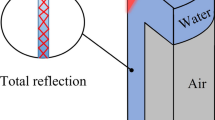Abstract
Compared with traditional EDM, ultrasonic vibration assisted EDM (UEDM) shows better performance in machining efficiency and surface quality. However, the material removal process of UEDM is complex, and there are many influencing factors. It is difficult to describe the material removal process accurately. In this study, based on the voltage variation during UEDM processing and combined with the heat transfer theory, the material removal model of TC4 titanium alloy under the condition of single pulse vertical UEDM is established. The material removal process of UEDM under different amplitudes is analyzed. The machining efficiency and surface quality of UEDM with different amplitude of ultrasonic vibration under the condition of vertical ultrasonic vibration are verified by UEDM experiments. The best material removal rate (MRR) can be obtained by adjusting the current and ultrasonic amplitude, which can improve the efficiency of UEDM.


source distribution








Similar content being viewed by others
Availability of data and materials
All data generated or analyzed during this study are included in this published article.
References
Wang Y, Liu ZQ, Shi J, Dong YH, Yang S, Zhang XF, Lin B (2020) Analysis of material removal and surface generation mechanism of ultrasonic Vibration-assisted EDM. Int J Adv Manuf Technol 110(1–2):177–189. https://doi.org/10.1007/s00170-020-05769-x
Yang XX (2015) Principle and process application of EDM. National Defense Industry Press, Beijing
Kremer D, Lebrun JL, Hosari B (1989) Effects of ultrasonic vibrations on the performances in EDM. Annals of the CIRP 38(1):199–202
Kremer D, Lhiaubt C, Moisan A (1991) A study of the effect of synchronizing ultrasonic vibrations with pulses in EDM. Annals of the CIRP 40(1):211–214
Lin YC, Yan BH, Chang YS (2000) Machining characteristics of titanium alloy (Ti–6Al–4V) using a combination process of EDM with USM. J Mater Process Technol 104(3):171–177. https://doi.org/10.1016/S0924-0136(00)00539-2
Abdullah A, Shabgard MR (2008) Effect of ultrasonic vibration of tool on electrical discharge machining of cemented tungsten carbide (WC-Co). Int J Adv Manuf Technol 38(11–12):1137–1147. https://doi.org/10.1007/s00170-007-1168-8
Abdullah A, Shabgard MR, Ivanov A (2009) Effect of ultrasonic assisted EDM on the surface integrity of cemented tungsten carbide (WC-Co). Int J Adv Manuf Technol 41(3–4):268–280. https://doi.org/10.1007/s00170-008-1476-7
Shabgard MR, Alenabi H (2015) Ultrasonic assisted electrical discharge machining of Ti-6Al-4V alloy. Mater Manuf Process 30(8):991–1000. https://doi.org/10.1080/10426914.2015.1004686
Li HC, Wang ZL, Wang YK, Liu HZ, Zhao ZX (2018) Micro-EDM and micro-USM combined milling of ZrB2-SiC-graphite composite for 3D micro-cavities. Int J Adv Manuf Technol 99:2635–2645. https://doi.org/10.1007/s00170-018-2568-7
Liu Y, Chang H, Zhang WC (2018) A simulation study of debris removal process in ultrasonic vibration assisted electrical discharge machining (EDM) of deep holes. Micromachines 9(8):378. https://doi.org/10.3390/mi9080378
Choubey M, Maity KP, Sharma A (2020) Finite element modeling of material removal rate in micro-EDM process with and without ultrasonic vibration. Grey Systems: Theory and Application 10(3):311–319. https://doi.org/10.1108/GS-11-2019-0047
Li ZK, Bai J (2017) Impulse discharge method to investigate the influence of gap width on discharge characteristics in micro-EDM. Int J Adv Manuf Technol 90(5–8):1769–1777. https://doi.org/10.1007/s00170-016-9508-1
Giridharan A, Samuel GL (2015) Modeling and analysis of crater formation during wire electrical discharge turning (WEDT) process. Int J Adv Manuf Technol 77(5–8):1229–1247. https://doi.org/10.1007/s00170-014-6540-x
Dibitoto DD, Eubank PT, Patel MR, Barrufet MA (1989) Theoretical models of the electrical discharge machining process. I. A simple cathode erosion model. J Appl Phys 66(9):4095–4103
Shabgard M, Ahmadi R, Seyedzavvar M, Oliaei SNB (2013) Mathematical and numerical modeling of the effect of input-parameters on the flushing efficiency of plasma channel in EDM process. Int J Mach Tool Manuf 65:79–87. https://doi.org/10.1016/j.ijmachtools.2012.10.004
Ikai T, Fujita I, Hashiguchi K (1995) Heat input for crater formationin EDM. Proceedings of International Symposium for Electro Machining-ISEMXI. EPFL, Lausanne, Switzerland, pp 163–170
Joshi SN, Pande SS (2009) Development of an intelligent process model for EDM. Int J Adv Manuf Technol 45(3–4):300–317. https://doi.org/10.1007/s00170-009-1972-4
Dong YH, Li GY, Wang Y, Song JB, Yang S, Yu HY(2021) Study on the effective discharge energy mechanism of vertical ultrasonic vibration assisted EDM. Proc IMechE Part B: J Eng Manuf 1–9. https://doi.org/10.1177/09544054211028527
Funding
This work supported by Natural Science Foundation of Tianjin City (18JCYBJC88900, 18JCQNJC05200, 18JCQNJC75300) and National Natural Science Foundation of China (51505334).
Author information
Authors and Affiliations
Contributions
All authors contributed to the study conception and design. Material preparation, data collection, and analysis were performed by Yinghuai Dong, Jiajun Liu, Guangyan Li, and Yan Wang. The first draft of the manuscript was written by Jiajun Liu, and all authors commented on previous versions of the manuscript. All authors read and approved the final manuscript.
Corresponding author
Ethics declarations
Ethics approval
Not applicable.
Consent to participate
Not applicable.
Consent for publication
Not applicable.
Competing interest
The authors declare no competing interests.
Additional information
Publisher's Note
Springer Nature remains neutral with regard to jurisdictional claims in published maps and institutional affiliations.
Rights and permissions
About this article
Cite this article
Dong, Y., Liu, J., Li, G. et al. Thermodynamic simulation modeling analysis and experimental research of vertical ultrasonic vibration assisted EDM. Int J Adv Manuf Technol 119, 5303–5314 (2022). https://doi.org/10.1007/s00170-021-08604-z
Received:
Accepted:
Published:
Issue Date:
DOI: https://doi.org/10.1007/s00170-021-08604-z




